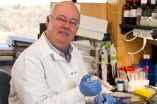(Press-News.org) Researchers at North Carolina State University have come up with a technique to embed needle-like carbon nanofibers in an elastic membrane, creating a flexible "bed of nails" on the nanoscale that opens the door to development of new drug-delivery systems.
The research community is interested in finding new ways to deliver precise doses of drugs to specific targets, such as regions of the brain. One idea is to create balloons embedded with nanoscale spikes that are coated with the relevant drug. Theoretically, the deflated balloon could be inserted into the target area and then inflated, allowing the spikes on the balloon's surface to pierce the surrounding cell walls and deliver the drug. The balloon could then be deflated and withdrawn.
But to test this concept, researchers first needed to develop an elastic material that is embedded with these aligned, nanoscale needles. That's where the NC State research team came in.
"We have now developed a way of embedding carbon nanofibers in an elastic silicone membrane and ensuring that the nanofibers are both perpendicular to the membrane's surface and sturdy enough to impale cells," says Dr. Anatoli Melechko, an associate professor of materials science and engineering at NC State and co-author of a paper on the work.
The researchers first "grew" the nanofibers on an aluminum bed, or substrate. They then added a drop of liquid silicone polymer. The polymer, nanofibers and substrate were then spun, so that centrifugal force spread the liquid polymer in a thin layer between the nanofibers – allowing the nanofibers to stick out above the surface. The polymer was then "cured," turning the liquid polymer into a solid, elastic membrane. Researchers then dissolved the aluminum substrate, leaving the membrane embedded with the carbon nanofibers "needles."
"This technique is relatively easy and inexpensive," says Melechko, "so we are hoping this development will facilitate new research on targeted drug-delivery methods."
INFORMATION:
The paper, "Transfer of Vertically Aligned Carbon Nanofibers to Polydimethylsiloxane (PDMS) while Maintaining their Alignment and Impalefection Functionality," is published online in the journal ACS Applied Materials & Interfaces. Lead authors on the paper are Ryan Pearce, a Ph.D. student at NC State, and Justin Railsback, a former NC State student now pursuing a Ph.D. at Northwestern University. Co-authors are Melechko; Dr. Joseph Tracy, an assistant professor of materials science and engineering at NC State; Bryan Anderson and Mehmet Sarac, Ph.D. students at NC State; and Timothy McKnight of Oak Ridge National Laboratory.
The research was supported by the National Science Foundation and the Department of Defense, Defense Threat Reduction Agency.
Researchers create flexible, nanoscale 'bed of nails' for possible drug delivery
2013-01-15
ELSE PRESS RELEASES FROM THIS DATE:
Lack of protein Sp2 disrupts neuron creation in brain
2013-01-15
A protein known as Sp2 is key to the proper creation of neurons from stem cells, according to researchers at North Carolina State University. Understanding how this protein works could enable scientists to "program" stem cells for regeneration, which has implications for neural therapies.
Troy Ghashghaei and Jon Horowitz, both faculty in NC State's Department of Molecular Biomedical Sciences and researchers in the Center for Comparative Medicine and Translational Research, wanted to know more about the function of Sp2, a cell cycle regulator that helps control how cells ...
Never forget a Face(book) -- memory for online posts beats faces and books
2013-01-15
People's memory for Facebook posts is strikingly stronger than their memory for human faces or sentences from books, according to a new study.
The findings shed light on how our memories favour natural, spontaneous writing over polished, edited content, and could have wider implications for the worlds of education, communications and advertising.
The research, authored by academics at the University of Warwick (Dr Laura Mickes) and UC San Diego (including Professors Christine Harris and Nicholas Christenfeld), tested memory for text taken from anonymised Facebook updates, ...
Facebook beats books - and faces - in memory test
2013-01-15
If this were a Facebook post, you would remember it – better than a stranger's face or a line from a published book.
That, in fewer than 140 characters, is the finding of research from the University of California, San Diego and the University of Warwick, published in the Springer journal Memory & Cognition.
Oh, and: The small, social-networking faux pas you were hoping would fade from your friends' memories real soon…? Don't count on it. Sorry. :/
In "Major Memory for Microblogs," the researchers report that Facebook status updates were about one and a half times ...
War was central to Europe's first civilization, contrary to popular belief
2013-01-15
Research from the University of Sheffield has discovered that the ancient civilisation of Crete, known as Minoan, had strong martial traditions, contradicting the commonly held view of Minoans as a peace-loving people.
The research, carried out by Dr Barry Molloy of the University of Sheffield's Department of Archaeology, investigated the Bronze Age people of Crete, known by many as the Minoans, who created the very first complex urban civilisation in Europe.
"Their world was uncovered just over a century ago, and was deemed to be a largely peaceful society," explained ...
Federal Supplemental Nutrition Assistance Program use grows in 2011
2013-01-15
DURHAM, N.H. – In 2011, 13 percent of all American households relied on the Supplemental Nutrition Assistance Program (SNAP) -- the program formerly known as food stamps – with nearly 6.2 million more American households using the program now than five years ago, according to new research from the Carsey Institute at the University of New Hampshire.
"The Great Recession had profound effects on families across the United States, and economic recovery has been slow. Poverty and unemployment remained high in 2011, and job growth was stagnant. Amid these signs of a sluggish ...
Researchers identify genetic mutation for rare cancer
2013-01-15
By looking at the entire DNA from this one patient's tumor, researchers have found a genetic anomaly that provides an important clue to improving how this cancer is diagnosed and treated.
Researchers at the University of Michigan Comprehensive Cancer Center sequenced the tumor's genome through a new program called MI-ONCOSEQ, which is designed to identify genetic mutations in tumors that might be targeted with new therapies being tested in clinical trials.
The sequencing also allows researchers to find new mutations. In this case, an unusual occurrence of two genes ...
A quantum leap in gene therapy of Duchenne muscular dystrophy
2013-01-15
COLUMBIA, Mo.-- Usually, results from a new study help scientists inch their way toward an answer whether they are battling a health problem or are on the verge of a technological breakthrough. Once in a while, those results give them a giant leap forward. In a preliminary study in a canine model of Duchenne muscular dystrophy (DMD), University of Missouri scientists showed exactly such a leap using gene therapy to treat muscular dystrophy. The results of the study will be published in the journal Molecular Therapy on Jan. 15, 2013.
Muscular dystrophy occurs when damaged ...
New path discovered for future generation of glucose-measuring biosensors
2013-01-15
CIC bioGUNE researchers have opened a new pathway for the future development of biosensors that enable measuring the glucose in the blood, but which are also believed to be more reliable with other fluids, such as urine. To this end, a complex scientific process has been developed which has called into question a dominant paradigm amongst the scientific community with respect to the mechanisms of binding and communication between proteins.
The mechanisms of communication at subcellular level are based on the interaction between proteins or between proteins and metabolites ...
Plumber and spray painter high-risk occupations for asthma
2013-01-15
Despite known risks and recommendations for protective equipment, many people are still affected with asthma after exposure to chemicals at work. This is the finding of an international study of 13,000 people carried out at the Sahlgrenska Academy, University of Gothenburg, Sweden.
Asthma is among the most common adult diseases in the world. Despite the fact that the risks of chemical exposure have long been known and that there are well-established recommendations for handling chemicals and protective equipment, many cases of asthma are still caused by exposure to toxic ...
How the protein transport machinery in the chloroplasts of higher plants developed
2013-01-15
Halfway between bacteria and tree
How the protein transport machinery in the chloroplasts of higher plants developed
Moss Physcomitrella patens is an evolutionary intermediate stage
Together with colleagues from Sweden, RUB researchers have studied how the protein transport system of bacteria developed over time to form the system in the chloroplasts of higher plants. They explored the so-called signal recognition particles (SRP) and their receptors. Bioinformatic and biochemical analyses revealed that the moss Physcomitrella patens has evolutionarily old and new components ...



